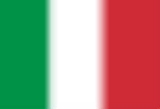
Royal Rhodesian Air Force
Encyclopedia
The Rhodesian Air Force was the air arm of the British colonial state of Rhodesia
. It existed between 1935 and 1980 under various names, and is now the Air Force of Zimbabwe
.
by 28 August. On 19 September 1939, two weeks after the United Kingdom
declared war against Germany
, the Air Unit officially became the Southern Rhodesia Air Force (SRAF), and Air Unit flights become Number 1 Squadron SRAF.
In 1939, the Southern Rhodesia government amalgamated the SRAF with the civilian airline Rhodesia And Nyasaland Airways (RANA
). The ex-RANA aircraft formed the Communication Squadron, which operated internal services within Southern Rhodesia, plus services to South Africa and Mozambique. By January 1940, with Britain at war with Germany, Royal Air Force (RAF) Air Vice-Marshal Sir Arthur 'Bomber' Harris
was desperate for trained aircrew and turned for help to Southern Rhodesia (where Harris had enlisted in 1914). Harris was frustrated by delays launching Commonwealth Air Training Plan
stations in Canada, Australia, New Zealand and South Africa. Southern Rhodesian Prime Minister Godfrey Huggins
(1933–53) recognised an opportunity not just to aid Britain and the Allies, but also to boost the domestic economy. The Rhodesian Air Training Group (RATG) installed aviation infrastructure, trained 10,000 Commonwealth and Allied airmen 1940–45 (seven percent of the total) and provided the stimulus for manufacturing that had been lacking in the 1920s and 1930s. Southern Rhodesia's textile, metallurgy, chemical and food processing industries expanded rapidly. The SRAF was absorbed into the RAF proper in April 1940 and redesignated No. 237 (Rhodesia) Squadron RAF
. This squadron, initially equipped with Hawker Hardys, participated in the East African Campaign
against the Italians.
On 1 June 1941, the Southern Rhodesian Women's Auxiliary Air Services came into being. British No. 44 Squadron RAF
and No. 266 Squadron RAF
were also assigned the name "(Rhodesia)" because of the large number of Rhodesian airmen and crew in these units. Rhodesians fought in many of the theatres of World War II
, the most notable of those in the contemporary era being Ian Smith
who, after being shot down over Italy
behind enemy lines, was able to avoid capture and return to Allied
lines. Rhodesian airmen suffered 20 percent fatalities, becoming emblematic of a ‘nation in arms’ ideal that peppered settler nationalism and erupted fully in the 1960s. The RAF remained until 1954, indirectly assisting Rhodesian aviation, and many airmen returned with young families as settlers.
The SRAF was re-established in 1947 and two years later, Huggins appointed a 32 year-old South African-born Rhodesian Spitfire pilot, Ted Jacklin, as air officer commanding tasked to build an air force in the expectation that British African territories would begin moving towards independence, and air power would be vital for land-locked Southern Rhodesia. The threadbare SRAF bought, borrowed or salvaged a collection of vintage aircraft, including six Tiger Moths, six Harvard trainers, an Anson
freighter and a handful of De Havilland Rapide transport aircraft, before purchasing a squadron of 22 Mk22 war surplus Spitfires
from the RAF which were then flown to Southern Rhodesia.
Huggins was anxious to maintain the strong wartime links established with the RAF, not only for access to training and new technology, but also because of his growing concern over the expansionist ideas of the newly-established apartheid Afrikaner
nationalist regime in South Africa. The booming Rhodesian economy allowed more money to be allocated for new aircraft, training and aerodrome facilities, and growing cooperation with the RAF in the 1950s saw the SRAF operating in Northern Rhodesia and Nyasaland, Kenya, Cyprus, Egypt, Jordan, Iraq, Oman and South Yemen. Huggins maintained his enthusiasm for air power when he became the first prime minister (1953–56) of the semi-independent Federation of Rhodesia and Nyasaland
also known as the Central African Federation (CAF) comprising Southern Rhodesia, Northern Rhodesia and Nyasaland. The CAF was viewed as an experiment, a democratic multiracial alternative to apartheid South Africa and it was widely expected that the new federal state would become independent within a decade The SRAF became a 'federal' body and received its first jets, 16 de Havilland Vampire
FB9 aircraft. On 15 October 1954 the federal air arm was officially designated as the Royal Rhodesian Air Force (RRAF). In a well-received move aimed to distinguish the RRAF from the South African Air Force, khaki uniforms and army ranks were abandoned in favour of those utilised by other Commonwealth air forces such as the RAF, RCAF, RAAF and RNZAF.
Despite efforts to broker a consensus, black and white Rhodesians complained that the pace of reform was too slow or too fast and by 1961, it became clear that the Federation was doomed. Following the dissolution of the CAF in 1963, the British government granted independence to Northern Rhodesia (Zambia) and Nyasaland (Malawi) but refused Southern Rhodesia independence until more progress was made towards multiracial democracy. White settler opinion hardened and Ian Smith's Rhodesian Front government issued a Unilateral Declaration of Independence in 1965. Chief of the Air Staff Air Vice Marshal 'Raf' Bentley was representing Rhodesia in Washington, D.C, and resigned immediately. Bentley's reluctant successor, former Royal Australian Air Force
pilot Harold Hawkins had come to Rhodesia with the RATG in 1944 and joined the SRAF in 1947. Hawkins accepted command of the RRAF in the increasingly forlorn hope that the rebellion could be resolved peacefully through negotiation. Although Southern Rhodesia acquired the lion's share of the Federation's aircraft, the imposition of international economic sanctions in 1965 saw the country abandoned by many aircraft equipment suppliers and maintenance contractors. RRAF aircraft maintenance crews had stockpiled essential items, but the Air Staff knew that metal fatigue, spare parts shortages and the need for new electronic equipment would begin to erode the RRAF's capabilities. In 1968, Air Vice Marshal Hawkins failed to convince Prime Minister Ian Smith that the 'HMS Fearless' settlement threatened by British Prime Minister Harold Wilson
was the best result that Rhodesia could expect. Hawkins resigned his command but accepted the post of Rhodesia's diplomatic representative in Pretoria. When the Rhodesian 'Bush War' intensified after 1972, the age of the aircraft, the shortage of spares and a deteriorating air safety record would become a growing concern for the Air Staff. The abrupt switch of allies saw Rhodesia increasingly dependent upon South African support and growing disillusion with the rebellion. In contrast to most of the police and the Army, Rhodesian airmen possessed skills in demand by other air forces and civilian airlines and the Air Staff struggled to retain, recruit and train technicians.
In the late 1950s, 16 Canberra B2 and T4 bombers
were purchased, as well as Provost T52 trainers, C-47 Dakota
and Canadair DC-4M Argonaut transports.
In 1962, Hunter fighter aircraft
were obtained, and the Vampire FB9 and T55s
were reallocated to advanced training and ground attack roles.
The first Alouette III helicopters also arrived around this time, equipping Number 7 Squadron.
, with green/yellow/green bars on each side of the fuselage roundel and type A fin flashes.
The RRAF used standard RAF type A roundels with three small assegai
s in black and white superimposed on the red center and type A fin flashes.. These assegais represented the three territories of the Federation, namely Southern Rhodesia
, Northern Rhodesia
and Nyasaland
.
The Rhodesian Air Force changed to a type D roundel with a single assegai and a type D in flash.
When Rhodesia became a republic in 1970 the roundels became a green ring with a lion and tusk on the white center.
Work started on the military section of the airfield in 1951. In March 1952, the New Air Headquarters and Technical Headquarters were completed at what was called New Sarum Air Force Base. The name derived from Salisbury's sister city
in Wiltshire
, England
, which for centuries had used the name "Sarum". The RAF station near the English Salisbury was called "Old Sarum
". It was therefore appropriate in view of both similarities in name and close association with the Royal Air Force that the new airfield be called "New Sarum."
New Sarum is still regarded as the principal Air Force establishment and provides facilities for four squadrons of aircraft of widely differing roles as well as housing training schools for technicians, security personnel, dog handlers, and the Air Force Regiment. The schools and flying squadrons are supported by a full range of services and amenities including workshops, transport fleets, living quarters, equipment depots, and sporting & entertainment facilities. The station shares with Harare International Airport
, one of the longest civil airport runways in the world, 4,725 metres (15,502 ft) or 2.93 miles, but is otherwise a totally self-contained community. The military site, complete with housing complex, is to the south of the crossing runways, whereas the international airport is to the north. .
responsible for training aircrews for the defence of the Empire
during World War II. The most suitable site comprised a portion of Thornhill farm and an adjacent farm, Glengarry. This land was commandeered for the duration of the War and finally purchased in 1947. The first buildings were constructed in 1941 and official use and the beginning of training began in March 1942. Some of the original buildings of this time are still in use at Thornhill today.
The town of Gwelo and the air station grew during World War II. A total of 1810 pilots were trained during this time. Many of these men returned after the war to settle in Rhodesia. Some of them formed the nucleus of the military training schemes which led to the formation of the Southern Rhodesian Air Force.
Thornhill is the home to the fighter squadrons, the training squadrons, and the Pilot Training School, where all Officer Cadets spend up to six months on initial training before beginning flying training with the squadrons. Like New Sarum, Thornhill shares its runway and Air Traffic Control
facilities with civil aircraft operators. The military air traffic controllers based at Thornhill are responsible for all air traffic control in the Midlands area.
|
|}
.svg.png) During the "Emergency"
During the "Emergency"
the air force consisted of no more than 2,300 personnel and of those only 150 were pilots. These pilots were qualified to fly all the aircraft within the air force so were often involved in combat missions. In addition, they were rotated through the various units so as to give rest to the airmen who would otherwise be constantly on active service.
In March 1970, when Rhodesia declared itself a republic, the prefix "Royal" was dropped and the Service's name became the Rhodesian Air Force (RhAF). A new roundel was adopted in the new Rhodesian colours of green and white containing a lion (in gold) and tusk in the centre of the white. The new air force ensign was taken into use on 5 April 1970. The new flag contained the Rhodesian flag in the canton with the roundel in the fly on a light blue field. This marking was displayed in the usual six positions, together with a green/white/green fin flash with a narrow white stripe as in RAF type C.
During the 1970s bush war, Rhodesia managed to obtain Rheims-Cessna 337
(known in Rhodesia as the Lynx), and SIAI Machetti SF260 (known in Rhodesia as the Genet or Warrior – two versions, trainer and ground-attack) piston engined aircraft, Bell 204 Iroquois
(from Israel), and additional Aérospatiale Alouette III
helicopters via covert means, but proved unsuccessful in obtaining jet aircraft (except for some Vampires
FB9 and T11 aircraft from South Africa). An order for CT/4 trainers was embargoed by the New Zealand government
Drawing upon counter-insurgency experience gained in the Second World War, the Malayan Emergency
and the Mau Mau uprising in Kenya, and adapting more recent Israeli, South African and Portuguese tactics, Rhodesian combined operations (police Special Branch
, army, air force) developed ‘pseudo-guerrillas’, such as the Mozambican National Resistance, (RENAMO) that wreaked havoc across the border, where Zimbabwe African National Liberation Army
(ZANLA) guerrilla camps were razed by ‘Fireforce
’ cross-border raids. Fireforce comprised units of Selous Scouts
, an undercover tracker battalion of 1,500 troops on double pay, 80 percent black, (many recruited by Special Branch from captured guerrillas facing trial and execution) probing ahead of a parachute infantry battalion and up to 200 Special Air Service commandos. These forces were supported, in turn, by armoured transport columns, mobile field artillery, equestrian pursuit dragoons, (Grey's Scouts
) air force helicopter gunships and bomber squadrons, one newly-equipped with 20 French-made Cessna Lynx low-altitude surveillance aircraft modified for precision ground attacks. Fireforce gathered intelligence, disrupted guerrilla forces, seized equipment and is identified frequently as a precursor of new forms of counterinsurgency warfare. The United Nations condemned the Fireforce raids.
For ground defence, the Rhodesian Air Force had their own armoured car unit equipped with Eland 60
s armed with 60 mm breech loading mortars.
 In June 1979, the short-lived Zimbabwe-Rhodesia government of Bishop Muzorewa
In June 1979, the short-lived Zimbabwe-Rhodesia government of Bishop Muzorewa
was installed and the air force flag was the only military flag to be changed to coincide with the change in the national flag. The roundel remained the same.
In the last year of the Rhodesian War and the first few years of Zimbabwe's independence, no national insignia of any sort were carried on Air Force aircraft. This was legal as long as the aircraft did not fly outside of the country's borders.
Following the independence of Zimbabwe in April 1980, the air force was renamed the Air Force of Zimbabwe
, but continued to use the emblem of a Bateleur
eagle in flight, as used by the Rhodesians. The new air force flag retains the light blue field and has the Zimbabwe flag in the canton with the air force emblem in gold in the fly.
In 1982, a new post-independence marking was introduced, featuring a yellow Zimbabwe Bird sitting on the walls of Great Zimbabwe
. This marking was displayed on the fin of the aircraft or on the fuselage of helicopters. No wing markings were displayed.
In 1994, a new roundel was introduced, featuring the national colours in concentric rings. Initially, the roundel was used in association with the 'Zimbabwe Bird' tail marking used previously, but this was soon replaced by the national flag. The main marking is normally displayed above and below each wing and on each side of the fuselage. However, this seems to be changed, and today the Zimbabwe Bird is also used as a fin flash.
Rhodesia
Rhodesia , officially the Republic of Rhodesia from 1970, was an unrecognised state located in southern Africa that existed between 1965 and 1979 following its Unilateral Declaration of Independence from the United Kingdom on 11 November 1965...
. It existed between 1935 and 1980 under various names, and is now the Air Force of Zimbabwe
Air Force of Zimbabwe
The Air Force of Zimbabwe is the air force of the Zimbabwe Defence Forces. It was known as the Rhodesian Air Force until 1980. The Air Force of Zimbabwe saw service in the Mozambican Civil War in 1985 and the Second Congo War of 1998–2001....
.
History
Formed in 1935 under the name Southern Rhodesia Staff Corps Air Unit as a territorial unit, the first regular servicemen with the unit went to Britain for ground crew training in 1936. Its first pilots were awarded their flying wings on 13 May 1938. The reservists were called up early August 1939 and were posted to CanadaCanada
Canada is a North American country consisting of ten provinces and three territories. Located in the northern part of the continent, it extends from the Atlantic Ocean in the east to the Pacific Ocean in the west, and northward into the Arctic Ocean...
by 28 August. On 19 September 1939, two weeks after the United Kingdom
United Kingdom
The United Kingdom of Great Britain and Northern IrelandIn the United Kingdom and Dependencies, other languages have been officially recognised as legitimate autochthonous languages under the European Charter for Regional or Minority Languages...
declared war against Germany
Germany
Germany , officially the Federal Republic of Germany , is a federal parliamentary republic in Europe. The country consists of 16 states while the capital and largest city is Berlin. Germany covers an area of 357,021 km2 and has a largely temperate seasonal climate...
, the Air Unit officially became the Southern Rhodesia Air Force (SRAF), and Air Unit flights become Number 1 Squadron SRAF.
In 1939, the Southern Rhodesia government amalgamated the SRAF with the civilian airline Rhodesia And Nyasaland Airways (RANA
Rana
Rana may refer to:In education:* Rana Institute of Higher Education, AfghanistanIn entertainment and sports:* Rana , forthcoming Indian film* Moon , the moon Rána in Tolkien's Middle-earth...
). The ex-RANA aircraft formed the Communication Squadron, which operated internal services within Southern Rhodesia, plus services to South Africa and Mozambique. By January 1940, with Britain at war with Germany, Royal Air Force (RAF) Air Vice-Marshal Sir Arthur 'Bomber' Harris
Sir Arthur Harris, 1st Baronet
Marshal of the Royal Air Force Sir Arthur Travers Harris, 1st Baronet GCB OBE AFC , commonly known as "Bomber" Harris by the press, and often within the RAF as "Butcher" Harris, was Air Officer Commanding-in-Chief of RAF Bomber Command during the latter half of World War...
was desperate for trained aircrew and turned for help to Southern Rhodesia (where Harris had enlisted in 1914). Harris was frustrated by delays launching Commonwealth Air Training Plan
British Commonwealth Air Training Plan
The British Commonwealth Air Training Plan , known in some countries as the Empire Air Training Scheme , was a massive, joint military aircrew training program created by the United Kingdom, Canada, Australia and New Zealand, during the Second World War...
stations in Canada, Australia, New Zealand and South Africa. Southern Rhodesian Prime Minister Godfrey Huggins
Godfrey Huggins, 1st Viscount Malvern
Godfrey Martin Huggins, 1st Viscount Malvern, CH, KCMG, PC was a Rhodesian politician and physician. He served as the fourth Prime Minister of Southern Rhodesia from 1933 to 1953 and remained in office as the first Prime Minister of the Federation of Rhodesia and Nyasaland until 1956, becoming the...
(1933–53) recognised an opportunity not just to aid Britain and the Allies, but also to boost the domestic economy. The Rhodesian Air Training Group (RATG) installed aviation infrastructure, trained 10,000 Commonwealth and Allied airmen 1940–45 (seven percent of the total) and provided the stimulus for manufacturing that had been lacking in the 1920s and 1930s. Southern Rhodesia's textile, metallurgy, chemical and food processing industries expanded rapidly. The SRAF was absorbed into the RAF proper in April 1940 and redesignated No. 237 (Rhodesia) Squadron RAF
No. 237 Squadron RAF
No. 237 Squadron was a Royal Air Force aircraft squadron. During the Second World War the unit was formed from No. 1 Squadron Southern Rhodesian Air Force for operations in North Africa.-History:...
. This squadron, initially equipped with Hawker Hardys, participated in the East African Campaign
East African Campaign (World War II)
The East African Campaign was a series of battles fought in East Africa during World War II by the British Empire, the British Commonwealth of Nations and several allies against the forces of Italy from June 1940 to November 1941....
against the Italians.
| Dates | Names |
|---|---|
| 1935–1936 | Air Section, 1st Battalion Rhodesia Regiment – |
| 1936–1938 | Air Section, Southern Rhodesia Defence Force |
| 1938–1939 | Southern Rhodesia Air Unit |
| 1939–1940 | No1 Squadron, Southern Rhodesia Air Force |
| 1940–1947 | No 237 (Rhodesia) Squadron No. 237 Squadron RAF No. 237 Squadron was a Royal Air Force aircraft squadron. During the Second World War the unit was formed from No. 1 Squadron Southern Rhodesian Air Force for operations in North Africa.-History:... Royal Air Force Royal Air Force The Royal Air Force is the aerial warfare service branch of the British Armed Forces. Formed on 1 April 1918, it is the oldest independent air force in the world... |
| 1947 | Communications Squadron, Southern Rhodesian Staff Corps |
| 1947–1954 | Southern Rhodesian Air Force |
| 1954–1970 | Royal Rhodesian Air Force |
| 1970–1980 | Rhodesian Air Force |
On 1 June 1941, the Southern Rhodesian Women's Auxiliary Air Services came into being. British No. 44 Squadron RAF
No. 44 Squadron RAF
No. 44 Squadron of the Royal Air Force is no longer operational. For most of its history it served as a heavy bomber squadron.-History:...
and No. 266 Squadron RAF
No. 266 Squadron RAF
-World War I:The squadron was formed from No's 437 and 438 Flights at Mudros, Greece on 27 September 1918 to carry out anti-submarine patrols in that area, flying Short 184s and 320s along with Felixtowe F.3s. In February 1919 it was transferred to the Caucasus on HMS Engadine. It operated from...
were also assigned the name "(Rhodesia)" because of the large number of Rhodesian airmen and crew in these units. Rhodesians fought in many of the theatres of World War II
World War II
World War II, or the Second World War , was a global conflict lasting from 1939 to 1945, involving most of the world's nations—including all of the great powers—eventually forming two opposing military alliances: the Allies and the Axis...
, the most notable of those in the contemporary era being Ian Smith
Ian Smith
Ian Douglas Smith GCLM ID was a politician active in the government of Southern Rhodesia, the Federation of Rhodesia and Nyasaland, Rhodesia, Zimbabwe Rhodesia and Zimbabwe from 1948 to 1987, most notably serving as Prime Minister of Rhodesia from 13 April 1964 to 1 June 1979...
who, after being shot down over Italy
Italy
Italy , officially the Italian Republic languages]] under the European Charter for Regional or Minority Languages. In each of these, Italy's official name is as follows:;;;;;;;;), is a unitary parliamentary republic in South-Central Europe. To the north it borders France, Switzerland, Austria and...
behind enemy lines, was able to avoid capture and return to Allied
Allies of World War II
The Allies of World War II were the countries that opposed the Axis powers during the Second World War . Former Axis states contributing to the Allied victory are not considered Allied states...
lines. Rhodesian airmen suffered 20 percent fatalities, becoming emblematic of a ‘nation in arms’ ideal that peppered settler nationalism and erupted fully in the 1960s. The RAF remained until 1954, indirectly assisting Rhodesian aviation, and many airmen returned with young families as settlers.
The SRAF was re-established in 1947 and two years later, Huggins appointed a 32 year-old South African-born Rhodesian Spitfire pilot, Ted Jacklin, as air officer commanding tasked to build an air force in the expectation that British African territories would begin moving towards independence, and air power would be vital for land-locked Southern Rhodesia. The threadbare SRAF bought, borrowed or salvaged a collection of vintage aircraft, including six Tiger Moths, six Harvard trainers, an Anson
Avro Anson
The Avro Anson is a British twin-engine, multi-role aircraft that served with the Royal Air Force, Fleet Air Arm and numerous other air forces prior to, during, and after the Second World War. Named for British Admiral George Anson, it was originally designed for maritime reconnaissance, but was...
freighter and a handful of De Havilland Rapide transport aircraft, before purchasing a squadron of 22 Mk22 war surplus Spitfires
Supermarine Spitfire
The Supermarine Spitfire is a British single-seat fighter aircraft that was used by the Royal Air Force and many other Allied countries throughout the Second World War. The Spitfire continued to be used as a front line fighter and in secondary roles into the 1950s...
from the RAF which were then flown to Southern Rhodesia.
Huggins was anxious to maintain the strong wartime links established with the RAF, not only for access to training and new technology, but also because of his growing concern over the expansionist ideas of the newly-established apartheid Afrikaner
Afrikaner
Afrikaners are an ethnic group in Southern Africa descended from almost equal numbers of Dutch, French and German settlers whose native tongue is Afrikaans: a Germanic language which derives primarily from 17th century Dutch, and a variety of other languages.-Related ethno-linguistic groups:The...
nationalist regime in South Africa. The booming Rhodesian economy allowed more money to be allocated for new aircraft, training and aerodrome facilities, and growing cooperation with the RAF in the 1950s saw the SRAF operating in Northern Rhodesia and Nyasaland, Kenya, Cyprus, Egypt, Jordan, Iraq, Oman and South Yemen. Huggins maintained his enthusiasm for air power when he became the first prime minister (1953–56) of the semi-independent Federation of Rhodesia and Nyasaland
Federation of Rhodesia and Nyasaland
The Federation of Rhodesia and Nyasaland, also known as the Central African Federation , was a semi-independent state in southern Africa that existed from 1953 to the end of 1963, comprising the former self-governing colony of Southern Rhodesia and the British protectorates of Northern Rhodesia,...
also known as the Central African Federation (CAF) comprising Southern Rhodesia, Northern Rhodesia and Nyasaland. The CAF was viewed as an experiment, a democratic multiracial alternative to apartheid South Africa and it was widely expected that the new federal state would become independent within a decade The SRAF became a 'federal' body and received its first jets, 16 de Havilland Vampire
De Havilland Vampire
The de Havilland DH.100 Vampire was a British jet-engine fighter commissioned by the Royal Air Force during the Second World War. Following the Gloster Meteor, it was the second jet fighter to enter service with the RAF. Although it arrived too late to see combat during the war, the Vampire served...
FB9 aircraft. On 15 October 1954 the federal air arm was officially designated as the Royal Rhodesian Air Force (RRAF). In a well-received move aimed to distinguish the RRAF from the South African Air Force, khaki uniforms and army ranks were abandoned in favour of those utilised by other Commonwealth air forces such as the RAF, RCAF, RAAF and RNZAF.
Despite efforts to broker a consensus, black and white Rhodesians complained that the pace of reform was too slow or too fast and by 1961, it became clear that the Federation was doomed. Following the dissolution of the CAF in 1963, the British government granted independence to Northern Rhodesia (Zambia) and Nyasaland (Malawi) but refused Southern Rhodesia independence until more progress was made towards multiracial democracy. White settler opinion hardened and Ian Smith's Rhodesian Front government issued a Unilateral Declaration of Independence in 1965. Chief of the Air Staff Air Vice Marshal 'Raf' Bentley was representing Rhodesia in Washington, D.C, and resigned immediately. Bentley's reluctant successor, former Royal Australian Air Force
Royal Australian Air Force
The Royal Australian Air Force is the air force branch of the Australian Defence Force. The RAAF was formed in March 1921. It continues the traditions of the Australian Flying Corps , which was formed on 22 October 1912. The RAAF has taken part in many of the 20th century's major conflicts...
pilot Harold Hawkins had come to Rhodesia with the RATG in 1944 and joined the SRAF in 1947. Hawkins accepted command of the RRAF in the increasingly forlorn hope that the rebellion could be resolved peacefully through negotiation. Although Southern Rhodesia acquired the lion's share of the Federation's aircraft, the imposition of international economic sanctions in 1965 saw the country abandoned by many aircraft equipment suppliers and maintenance contractors. RRAF aircraft maintenance crews had stockpiled essential items, but the Air Staff knew that metal fatigue, spare parts shortages and the need for new electronic equipment would begin to erode the RRAF's capabilities. In 1968, Air Vice Marshal Hawkins failed to convince Prime Minister Ian Smith that the 'HMS Fearless' settlement threatened by British Prime Minister Harold Wilson
Harold Wilson
James Harold Wilson, Baron Wilson of Rievaulx, KG, OBE, FRS, FSS, PC was a British Labour Member of Parliament, Leader of the Labour Party. He was twice Prime Minister of the United Kingdom during the 1960s and 1970s, winning four general elections, including a minority government after the...
was the best result that Rhodesia could expect. Hawkins resigned his command but accepted the post of Rhodesia's diplomatic representative in Pretoria. When the Rhodesian 'Bush War' intensified after 1972, the age of the aircraft, the shortage of spares and a deteriorating air safety record would become a growing concern for the Air Staff. The abrupt switch of allies saw Rhodesia increasingly dependent upon South African support and growing disillusion with the rebellion. In contrast to most of the police and the Army, Rhodesian airmen possessed skills in demand by other air forces and civilian airlines and the Air Staff struggled to retain, recruit and train technicians.
In the late 1950s, 16 Canberra B2 and T4 bombers
English Electric Canberra
The English Electric Canberra is a first-generation jet-powered light bomber manufactured in large numbers through the 1950s. The Canberra could fly at a higher altitude than any other bomber through the 1950s and set a world altitude record of 70,310 ft in 1957...
were purchased, as well as Provost T52 trainers, C-47 Dakota
C-47 Skytrain
The Douglas C-47 Skytrain or Dakota is a military transport aircraft that was developed from the Douglas DC-3 airliner. It was used extensively by the Allies during World War II and remained in front line operations through the 1950s with a few remaining in operation to this day.-Design and...
and Canadair DC-4M Argonaut transports.
In 1962, Hunter fighter aircraft
Hawker Hunter
The Hawker Hunter is a subsonic British jet aircraft developed in the 1950s. The single-seat Hunter entered service as a manoeuvrable fighter aircraft, and later operated in fighter-bomber and reconnaissance roles in numerous conflicts. Two-seat variants remained in use for training and secondary...
were obtained, and the Vampire FB9 and T55s
De Havilland Vampire
The de Havilland DH.100 Vampire was a British jet-engine fighter commissioned by the Royal Air Force during the Second World War. Following the Gloster Meteor, it was the second jet fighter to enter service with the RAF. Although it arrived too late to see combat during the war, the Vampire served...
were reallocated to advanced training and ground attack roles.
The first Alouette III helicopters also arrived around this time, equipping Number 7 Squadron.
Insignia
The SRAF used standard RAF type A roundelRoyal Air Force roundels
The Royal Air Force roundel is a circular identification mark painted on aircraft to identify them to other aircraft and ground forces. In one form or another, it has been used on British military aircraft from 1915 to the present....
, with green/yellow/green bars on each side of the fuselage roundel and type A fin flashes.
The RRAF used standard RAF type A roundels with three small assegai
Assegai
An assegai or assagai is a pole weapon used for throwing or hurling, usually a light spear or javelin made of wood and pointed with iron.-Iklwa:...
s in black and white superimposed on the red center and type A fin flashes.. These assegais represented the three territories of the Federation, namely Southern Rhodesia
Southern Rhodesia
Southern Rhodesia was the name of the British colony situated north of the Limpopo River and the Union of South Africa. From its independence in 1965 until its extinction in 1980, it was known as Rhodesia...
, Northern Rhodesia
Northern Rhodesia
Northern Rhodesia was a territory in south central Africa, formed in 1911. It became independent in 1964 as Zambia.It was initially administered under charter by the British South Africa Company and formed by it in 1911 by amalgamating North-Western Rhodesia and North-Eastern Rhodesia...
and Nyasaland
Nyasaland
Nyasaland or the Nyasaland Protectorate, was a British protectorate located in Africa, which was established in 1907 when the former British Central Africa Protectorate changed its name. Since 1964, it has been known as Malawi....
.
The Rhodesian Air Force changed to a type D roundel with a single assegai and a type D in flash.
When Rhodesia became a republic in 1970 the roundels became a green ring with a lion and tusk on the white center.
Aircraft
|
 Hawker Hunter The Hawker Hunter is a subsonic British jet aircraft developed in the 1950s. The single-seat Hunter entered service as a manoeuvrable fighter aircraft, and later operated in fighter-bomber and reconnaissance roles in numerous conflicts. Two-seat variants remained in use for training and secondary...  Percival Pembroke -See also:-Bibliography:* The Illustrated Encyclopedia of Aircraft London: Orbis Publishing, 1985.* Jackson, A.J. British Civil Aircraft since 1919 . London: Putnam, 1974. ISBN 0-370-10014-X....  Percival Provost |-See also:-References:NotesBibliography* Angelucci, Enzo. World Encyclopedia of Military Aircraft. London: Jane's Publishing, 1981. ISBN 0-7106-0148-4....   Cessna Skymaster The Cessna Skymaster is a United States twin-engine civil utility aircraft built in a push-pull configuration. Its engines are mounted in the nose and rear of its pod-style fuselage. Twin booms extend aft of the wings to the vertical stabilizers, with the rear engine between them. The horizontal... – "Lynx"   Supermarine Spitfire The Supermarine Spitfire is a British single-seat fighter aircraft that was used by the Royal Air Force and many other Allied countries throughout the Second World War. The Spitfire continued to be used as a front line fighter and in secondary roles into the 1950s...  Douglas DC-7 The Douglas DC-7 is an American transport aircraft built by the Douglas Aircraft Company from 1953 to 1958. It was the last major piston engine powered transport made by Douglas, coming just a few years before the advent of jet aircraft such as the Boeing 707 and Douglas DC-8.-Design and... CF  Beechcraft Baron |-See also:- Further reading :*Harding, Stephen. U.S. Army Aircraft Since 1947. Shrewsbury, UK:Airlife Publishing, 1990. ISBN 1-85310-102-8.*Michell, Simon. Jane's Civil and Military Aircraft Upgrades 1994-95. Coulsdon, UK:Jane's Information Group, 1994. ISBN 0-7106-1208-7.*Taylor, John W. R.... |
 Cessna 421 -See also:-References:NotesBibliography* Taylor, John W.R. . Jane's All The World's Aircraft 1976-77. London:Jane's Yearbooks, 1976. ISBN 0-354-00538-3....  Hawker Hart The Hawker Hart was a British two-seater biplane light bomber of the Royal Air Force , which had a prominent role during the RAF's inter-war period. The Hart was designed during the 1920s by Sydney Camm and built by Hawker Aircraft...  De Havilland Dragon Rapide The de Havilland DH.89 Dragon Rapide was a British short-haul passenger airliner of the 1930s.-Design and development:Designed by the de Havilland company in late 1933 as a faster and more comfortable successor to the DH.84 Dragon, it was in effect a twin-engined, scaled-down version of the...   De Havilland Leopard Moth -See also:...  Auster Autocrat -External links:*...  Avro Anson The Avro Anson is a British twin-engine, multi-role aircraft that served with the Royal Air Force, Fleet Air Arm and numerous other air forces prior to, during, and after the Second World War. Named for British Admiral George Anson, it was originally designed for maritime reconnaissance, but was...  Auster Aiglet Trainer -See also:... |
- Aerospatiale Alouette II – Six helicopters on loan from the South African Air Force, in service from 1974 to 1980.
- Cessna 185Cessna 185-Specification for differing configurations:-References:* Jan Churchill, Hit My Smoke: Forward Air Controllers in Southeast Asia, Sunflower University Press, Manhattan KS, ISBN 0-89745-215-1...
Skywagon – Two civil aircraft impressed into service, about 17 aircraft on loan from the South African Air Force, in service during the 1970s.
New Sarum Air Force Base
In the early days of Rhodesian aviation, the various air units often lodged in buildings and facilities that they inherited. By the 1940s, it became apparent that a more permanent home for aviation was needed near the capital city, Salisbury. The decision was made to build a completely new airfield at Kentucky Farm to provide a base of operations for civilian airlines and military aircraft.Work started on the military section of the airfield in 1951. In March 1952, the New Air Headquarters and Technical Headquarters were completed at what was called New Sarum Air Force Base. The name derived from Salisbury's sister city
Salisbury
Salisbury is a cathedral city in Wiltshire, England and the only city in the county. It is the second largest settlement in the county...
in Wiltshire
Wiltshire
Wiltshire is a ceremonial county in South West England. It is landlocked and borders the counties of Dorset, Somerset, Hampshire, Gloucestershire, Oxfordshire and Berkshire. It contains the unitary authority of Swindon and covers...
, England
England
England is a country that is part of the United Kingdom. It shares land borders with Scotland to the north and Wales to the west; the Irish Sea is to the north west, the Celtic Sea to the south west, with the North Sea to the east and the English Channel to the south separating it from continental...
, which for centuries had used the name "Sarum". The RAF station near the English Salisbury was called "Old Sarum
Old Sarum Airfield
Old Sarum Airfield is located north northeast of Salisbury, Wiltshire, England.The aerodrome has a CAA Ordinary Licence that allows flights for the public transport of passengers or for flying instruction as authorised by the licensee . The aerodrome is not licensed for night use.The site is a...
". It was therefore appropriate in view of both similarities in name and close association with the Royal Air Force that the new airfield be called "New Sarum."
New Sarum is still regarded as the principal Air Force establishment and provides facilities for four squadrons of aircraft of widely differing roles as well as housing training schools for technicians, security personnel, dog handlers, and the Air Force Regiment. The schools and flying squadrons are supported by a full range of services and amenities including workshops, transport fleets, living quarters, equipment depots, and sporting & entertainment facilities. The station shares with Harare International Airport
Harare International Airport
Harare International Airport is an airport in Harare, Zimbabwe. The airport is operated by the Civil Aviation Authority of Zimbabwe and is the hub of Air Zimbabwe. The airport's runway, at , is one of the longest in Africa. It compares with OR Tambo International Airport in Johannesburg, South...
, one of the longest civil airport runways in the world, 4,725 metres (15,502 ft) or 2.93 miles, but is otherwise a totally self-contained community. The military site, complete with housing complex, is to the south of the crossing runways, whereas the international airport is to the north. .
Thornhill Air Force Base
In 1939 a committee was set up to locate and survey three sites in the Gwelo area that were suitable for the establishment of an airfield for the Commonwealth Training GroupBritish Commonwealth Air Training Plan
The British Commonwealth Air Training Plan , known in some countries as the Empire Air Training Scheme , was a massive, joint military aircrew training program created by the United Kingdom, Canada, Australia and New Zealand, during the Second World War...
responsible for training aircrews for the defence of the Empire
British Empire
The British Empire comprised the dominions, colonies, protectorates, mandates and other territories ruled or administered by the United Kingdom. It originated with the overseas colonies and trading posts established by England in the late 16th and early 17th centuries. At its height, it was the...
during World War II. The most suitable site comprised a portion of Thornhill farm and an adjacent farm, Glengarry. This land was commandeered for the duration of the War and finally purchased in 1947. The first buildings were constructed in 1941 and official use and the beginning of training began in March 1942. Some of the original buildings of this time are still in use at Thornhill today.
The town of Gwelo and the air station grew during World War II. A total of 1810 pilots were trained during this time. Many of these men returned after the war to settle in Rhodesia. Some of them formed the nucleus of the military training schemes which led to the formation of the Southern Rhodesian Air Force.
Thornhill is the home to the fighter squadrons, the training squadrons, and the Pilot Training School, where all Officer Cadets spend up to six months on initial training before beginning flying training with the squadrons. Like New Sarum, Thornhill shares its runway and Air Traffic Control
Air traffic control
Air traffic control is a service provided by ground-based controllers who direct aircraft on the ground and in the air. The primary purpose of ATC systems worldwide is to separate aircraft to prevent collisions, to organize and expedite the flow of traffic, and to provide information and other...
facilities with civil aircraft operators. The military air traffic controllers based at Thornhill are responsible for all air traffic control in the Midlands area.
Officer Ranks
| Rank | Insignia | Nato Code |
|---|---|---|
| Air Marshal Air Marshal Air marshal is a three-star air-officer rank which originated in and continues to be used by the Royal Air Force... |
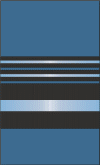 |
OF-8 3 star rank An officer of three-star rank is a very senior commander in many of the armed services holding a rank described by the NATO code of OF-8. The term is also used by some armed forces which are not NATO members... |
| Air Vice-Marshal Air Vice-Marshal Air vice-marshal is a two-star air-officer rank which originated in and continues to be used by the Royal Air Force. The rank is also used by the air forces of many countries which have historical British influence and it is sometimes used as the English translation of an equivalent rank in... |
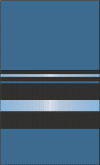 |
OF-7 2 star rank An officer of two-star rank is a senior commander in many of the armed services holding a rank described by the NATO code of OF-7. The term is also used by some armed forces which are not NATO members... |
| Air Commodore Air Commodore Air commodore is an air-officer rank which originated in and continues to be used by the Royal Air Force... |
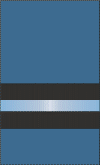 |
OF-6 1 star rank An officer of one-star rank is a senior commander in many of the armed services holding a rank described by the NATO code of OF-6. The term is also used by some armed forces which are not NATO members... |
| Group Captain Group Captain Group captain is a senior commissioned rank in the Royal Air Force and the air forces of many other Commonwealth countries. It ranks above wing commander and immediately below air commodore... |
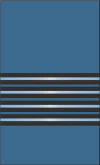 |
OF-5 |
| Wing Commander Wing Commander (rank) Wing commander is a commissioned rank in the Royal Air Force and the air forces of many other Commonwealth countries... |
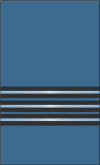 |
OF-4 |
| Squadron Leader Squadron Leader Squadron Leader is a commissioned rank in the Royal Air Force and the air forces of many countries which have historical British influence. It is also sometimes used as the English translation of an equivalent rank in countries which have a non-English air force-specific rank structure. In these... |
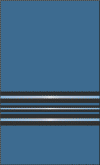 |
OF-3 |
| Flight Lieutenant Flight Lieutenant Flight lieutenant is a junior commissioned rank in the Royal Air Force and the air forces of many Commonwealth countries. It ranks above flying officer and immediately below squadron leader. The name of the rank is the complete phrase; it is never shortened to "lieutenant"... |
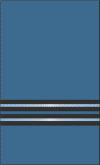 |
OF-2 Captain (OF-2) The army rank of captain is a commissioned officer rank historically corresponding to command of a company of soldiers. The rank is also used by some air forces and marine forces. Today a captain is typically either the commander or second-in-command of a company or artillery battery... |
| Air Lieutenant (Flying Officer Flying Officer Flying officer is a junior commissioned rank in the Royal Air Force and the air forces of many countries which have historical British influence... ) |
 |
OF-1 |
| Air Sub-Lieutenant (Pilot Officer Pilot Officer Pilot officer is the lowest commissioned rank in the Royal Air Force and the air forces of many other Commonwealth countries. It ranks immediately below flying officer... ) |
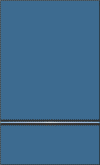 |
OF-1 |
|
Enlisted ranks
| Rank | Insignia | Nato Code |
|---|---|---|
| Warrant Officer Warrant Officer A warrant officer is an officer in a military organization who is designated an officer by a warrant, as distinguished from a commissioned officer who is designated an officer by a commission, or from non-commissioned officer who is designated an officer by virtue of seniority.The rank was first... Class (I) |
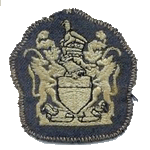 |
OR-9 |
| Warrant Officer Class (II) | 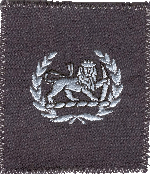 |
OR-9 |
| Master Technician | 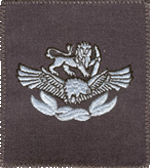 |
OR-9 |
| Master Sergeant Master Sergeant A master sergeant is the military rank for a senior non-commissioned officer in some armed forces.-Israel Defense Forces:Rav samal rishoninsignia IDF... |
 |
OR-8 |
| Flight Sergeant Flight Sergeant Flight sergeant is a senior non-commissioned rank in the British Royal Air Force and several other air forces which have adopted all or part of the RAF rank structure... |
 |
OR-7 |
| Sergeant Sergeant Sergeant is a rank used in some form by most militaries, police forces, and other uniformed organizations around the world. Its origins are the Latin serviens, "one who serves", through the French term Sergent.... |
 |
OR-5 |
| Corporal Corporal Corporal is a rank in use in some form by most militaries and by some police forces or other uniformed organizations. It is usually equivalent to NATO Rank Code OR-4.... |
 |
OR-4 |
| Senior Aircraftsman |  |
OR-2 |
| Leading Aircraftsman |  |
OR-2 |
| Aircraftsman | No Rank Insignia | OR-1 |
|}
Rhodesian Air Force (1970–1980)
.svg.png)
Rhodesian Bush War
The Rhodesian Bush War – also known as the Second Chimurenga or the Zimbabwe War of Liberation – was a civil war which took place between July 1964 and December 1979 in the unrecognised country of Rhodesia...
the air force consisted of no more than 2,300 personnel and of those only 150 were pilots. These pilots were qualified to fly all the aircraft within the air force so were often involved in combat missions. In addition, they were rotated through the various units so as to give rest to the airmen who would otherwise be constantly on active service.
In March 1970, when Rhodesia declared itself a republic, the prefix "Royal" was dropped and the Service's name became the Rhodesian Air Force (RhAF). A new roundel was adopted in the new Rhodesian colours of green and white containing a lion (in gold) and tusk in the centre of the white. The new air force ensign was taken into use on 5 April 1970. The new flag contained the Rhodesian flag in the canton with the roundel in the fly on a light blue field. This marking was displayed in the usual six positions, together with a green/white/green fin flash with a narrow white stripe as in RAF type C.
During the 1970s bush war, Rhodesia managed to obtain Rheims-Cessna 337
Cessna Skymaster
The Cessna Skymaster is a United States twin-engine civil utility aircraft built in a push-pull configuration. Its engines are mounted in the nose and rear of its pod-style fuselage. Twin booms extend aft of the wings to the vertical stabilizers, with the rear engine between them. The horizontal...
(known in Rhodesia as the Lynx), and SIAI Machetti SF260 (known in Rhodesia as the Genet or Warrior – two versions, trainer and ground-attack) piston engined aircraft, Bell 204 Iroquois
UH-1 Iroquois
The Bell UH-1 Iroquois is a military helicopter powered by a single, turboshaft engine, with a two-bladed main rotor and tail rotor. The helicopter was developed by Bell Helicopter to meet the United States Army's requirement for a medical evacuation and utility helicopter in 1952, and first flew...
(from Israel), and additional Aérospatiale Alouette III
Aérospatiale Alouette III
The Aérospatiale Alouette III is a single-engine, light utility helicopter developed by Sud Aviation. It was manufactured by Aérospatiale of France, and under licence by Hindustan Aeronautics Limited in India as Hal Chetak and Industria Aeronautică Română in Romania.The Alouette III is the...
helicopters via covert means, but proved unsuccessful in obtaining jet aircraft (except for some Vampires
De Havilland Vampire
The de Havilland DH.100 Vampire was a British jet-engine fighter commissioned by the Royal Air Force during the Second World War. Following the Gloster Meteor, it was the second jet fighter to enter service with the RAF. Although it arrived too late to see combat during the war, the Vampire served...
FB9 and T11 aircraft from South Africa). An order for CT/4 trainers was embargoed by the New Zealand government
Drawing upon counter-insurgency experience gained in the Second World War, the Malayan Emergency
Malayan Emergency
The Malayan Emergency was a guerrilla war fought between Commonwealth armed forces and the Malayan National Liberation Army , the military arm of the Malayan Communist Party, from 1948 to 1960....
and the Mau Mau uprising in Kenya, and adapting more recent Israeli, South African and Portuguese tactics, Rhodesian combined operations (police Special Branch
Special Branch
Special Branch is a label customarily used to identify units responsible for matters of national security in British and Commonwealth police forces, as well as in the Royal Thai Police...
, army, air force) developed ‘pseudo-guerrillas’, such as the Mozambican National Resistance, (RENAMO) that wreaked havoc across the border, where Zimbabwe African National Liberation Army
Zimbabwe African National Liberation Army
Zimbabwe African National Liberation Army was the military wing of the Zimbabwe African National Union, a militant African nationalist organization, and participated in the Rhodesian Bush War against Republican Rule in Rhodesia....
(ZANLA) guerrilla camps were razed by ‘Fireforce
Fireforce
Fireforce is a variant of the tactic of vertical envelopment of a target by helicopter-borne and parachute infantry developed by the Rhodesian Security Forces during the Rhodesian Bush War...
’ cross-border raids. Fireforce comprised units of Selous Scouts
Selous Scouts
The Selous Scouts was a special forces regiment of the Rhodesian Army, which operated from 1973 until the introduction of majority rule in 1980. It was named after British explorer Frederick Courteney Selous , and their motto was pamwe chete, which, in the Shona language, roughly means "all...
, an undercover tracker battalion of 1,500 troops on double pay, 80 percent black, (many recruited by Special Branch from captured guerrillas facing trial and execution) probing ahead of a parachute infantry battalion and up to 200 Special Air Service commandos. These forces were supported, in turn, by armoured transport columns, mobile field artillery, equestrian pursuit dragoons, (Grey's Scouts
Grey's Scouts
Grey's Scouts were a Rhodesian mounted infantry unit raised in July 1975 and named after George Grey, a prominent soldier in the Second Matabele War. Based in Salisbury , they were known for their participation in the Rhodesian Bush War...
) air force helicopter gunships and bomber squadrons, one newly-equipped with 20 French-made Cessna Lynx low-altitude surveillance aircraft modified for precision ground attacks. Fireforce gathered intelligence, disrupted guerrilla forces, seized equipment and is identified frequently as a precursor of new forms of counterinsurgency warfare. The United Nations condemned the Fireforce raids.
For ground defence, the Rhodesian Air Force had their own armoured car unit equipped with Eland 60
Eland Mk7
The Eland is a South African light armoured car based on the Panhard AML. Its permanent 4x4 drive gives it its mobility, and it can carry either a 90 mm quick firing low pressure gun, or a 60 mm breech loading mortar as main weapons...
s armed with 60 mm breech loading mortars.
Flying squadrons
- No. 1 Squadron – Thornhill (12 x Hawker Hunter FGA.9)
- No. 2 Squadron – Thornhill (8 x Vampire FB.9; 8 x Vampire T.55; plus 13 x Vampire FB.52 on loan from South Africa)
- No. 3 Squadron – New Sarum (13 x Douglas C-47; 1 x Cessna 402; 6 x BN-2A Islander; 1 x DC-7C; 1 x Baron)
- No. 4 Squadron – Thornhill (11 x AL-60F5 Trojan; 21 x Reims-Cessna FTB.337G; 14 x SF.260W)
- No. 5 Squadron – New Sarum (8 x EE Canberra B.2; 2 x EE Canberra T.4)
- No. 6 Squadron – Thornhill (13 x Percival Provost T.52; 17 x SF.260C)
- No. 7 Squadron – New Sarum (6 x Alouette II; 34 x Alouette III)
- No. 8 Squadron – New Sarum (11 x AB.205)
Air Force of Zimbabwe (1980–)

Abel Muzorewa
Bishop Abel Tendekayi Muzorewa served as Prime Minister of Zimbabwe Rhodesia from the Internal Settlement to the Lancaster House Agreement in 1979...
was installed and the air force flag was the only military flag to be changed to coincide with the change in the national flag. The roundel remained the same.
In the last year of the Rhodesian War and the first few years of Zimbabwe's independence, no national insignia of any sort were carried on Air Force aircraft. This was legal as long as the aircraft did not fly outside of the country's borders.
Following the independence of Zimbabwe in April 1980, the air force was renamed the Air Force of Zimbabwe
Air Force of Zimbabwe
The Air Force of Zimbabwe is the air force of the Zimbabwe Defence Forces. It was known as the Rhodesian Air Force until 1980. The Air Force of Zimbabwe saw service in the Mozambican Civil War in 1985 and the Second Congo War of 1998–2001....
, but continued to use the emblem of a Bateleur
Bateleur
The Bateleur is a medium-sized eagle in the bird family Accipitridae which also includes many other diurnal raptors such as buzzards, kites and harriers...
eagle in flight, as used by the Rhodesians. The new air force flag retains the light blue field and has the Zimbabwe flag in the canton with the air force emblem in gold in the fly.
In 1982, a new post-independence marking was introduced, featuring a yellow Zimbabwe Bird sitting on the walls of Great Zimbabwe
Great Zimbabwe
Great Zimbabwe is a ruined city that was once the capital of the Kingdom of Zimbabwe, which existed from 1100 to 1450 C.E. during the country’s Late Iron Age. The monument, which first began to be constructed in the 11th century and which continued to be built until the 14th century, spanned an...
. This marking was displayed on the fin of the aircraft or on the fuselage of helicopters. No wing markings were displayed.
In 1994, a new roundel was introduced, featuring the national colours in concentric rings. Initially, the roundel was used in association with the 'Zimbabwe Bird' tail marking used previously, but this was soon replaced by the national flag. The main marking is normally displayed above and below each wing and on each side of the fuselage. However, this seems to be changed, and today the Zimbabwe Bird is also used as a fin flash.
Commanders
The following officers were commanders of the Rhodesian Air Force:- 1949 – 30 June 1961 Air Vice-MarshalAir Vice-MarshalAir vice-marshal is a two-star air-officer rank which originated in and continues to be used by the Royal Air Force. The rank is also used by the air forces of many countries which have historical British influence and it is sometimes used as the English translation of an equivalent rank in...
"Ted" Jacklin - 1961 – 1965 Air Vice-Marshal Bentley
- 1965 – 1968 Air Vice-Marshal Harold Hawkins
- 1968 – 15 April 1973 Air MarshalAir MarshalAir marshal is a three-star air-officer rank which originated in and continues to be used by the Royal Air Force...
Archie WilsonArchibald WilsonAir Marshal Archibald O G Wilson ICD OBE DFC , commonly Archie Wilson, was a Rhodesian fighter pilot who served in the Royal Air Force during World War II.-RAF career:... - 13 April 1973 – 1977 Air Marshal Mick McLaren
- 12 April 1977 – 1981 Air Marshal Frank Mussell
External links
- Air Force of Zimbabwe
- Rhodesian Air Force and Rhodesian civil aircraft photographs and info
- The Rhodesian Air Force
- Rhodesian and South African Military History: An extensive collection of histories and analysis of Rhodesian and South African military operations, to the early 1980s
- Rhodesian Air Force Sods photos and videos
- Photos of the Rhodesian Bush War


